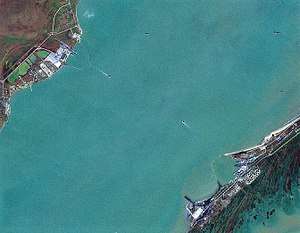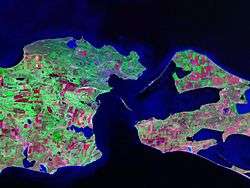Kerch Strait ferry line
The Kerch Strait ferry line (Russian: Керченская паромная переправа (also, переправа «Крым — Кавказ»), Ukrainian: Керченська поромна переправа) was the ferry connection across the Strait of Kerch that connected the Crimean Peninsula and Krasnodar Krai.
|
Satellite image of Kerch Strait. Left side is Crimea (green dot represents Kerch). Right side is Taman Peninsula, Russia (red dot represents Chushka Spit.) |

The ferry ran across the narrowest part of the strait (about 5 km) between Port Krym (harbour Crimea) by the city of Kerch and Port Kavkaz (harbour Caucasus) on the Chushka Spit, on the site of former Kerch railway bridge. It carried passengers, automotive and railroad transport. The ferry was on the European route E97 and connected its parts, А290 (formerly M25) and М-17 highways.
After the 2014 Russian annexation of Crimea, ferry traffic peaked, but as the Crimean Bridge across the strait opened, it overtook traffic flow from the ferry, rendering its usage for transportation financially unfeasible, so the ferry line stopped operations in late 2019.[1]
History
The ferry line was established in 1953, on the site of the former Kerch Railway bridge. From 1993 to 2004 railroad transportation was suspended due to replacement of aged train-ferries.[2]
Since the dissolution of the Soviet Union, it was administered by Russia and Ukraine through the joint venture “Crimea-Kuban Crossing”. In 1998, this company was reorganized into a Ukrainian state-owned enterprise "Kerch Strait ferry line". On 17 March 2014, during the annexation of Crimea by the Russian Federation, the company was nationalised by the Republic of Crimea, and had been since administered by Russia only.
The use of the ferry rose sharply after the annexation, and in June 2015, the ferry operator considered a daily passenger count of 11,000 normal.[3]
The 2018 opening of the road section of the new Crimean Bridge, crossing the strait about 10 km further south, and the projected 2019-2020 opening of the railway section of that bridge, have greatly reduced demand for the ferry, to the point that it stopped transportation operations in Autumn 2019 as financially unfeasible with then-current amounts of passenger and freight traffic.[1]
Gallery
 Yeysk car-ferry
Yeysk car-ferry Annenkov train-ferry
Annenkov train-ferry
See also
References
- "Керченская паромная переправа приостановила работу". Вести Крым (in Russian). 2019-11-21. Retrieved 2020-05-23.
- "Железнодорожные паромы в бывшем СССР (Rail ferries in the former USSR)" (in Russian). Retrieved March 22, 2014.
- http://www.c-inform.info/news/id/24379
